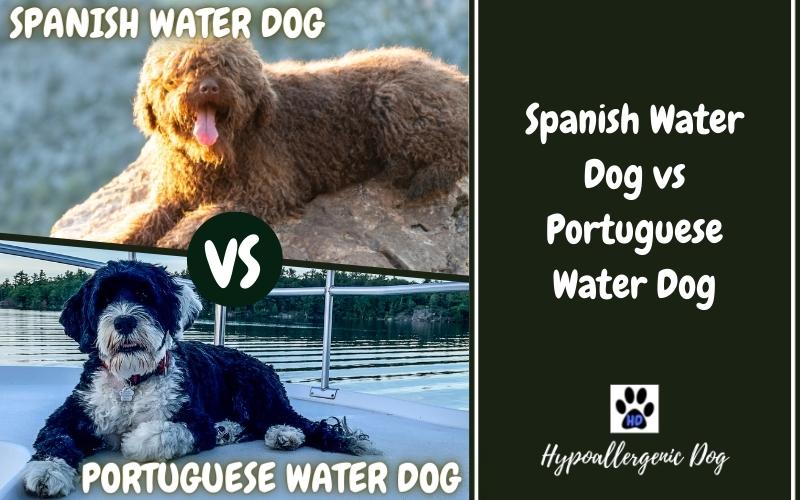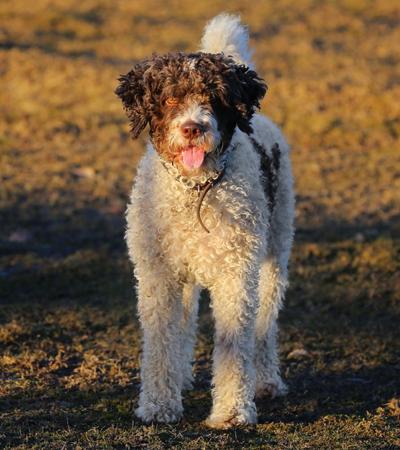The Spanish Water Dog vs Portuguese Water Dog — both originate from the Iberian Peninsular and share many other qualities. Yet there are a few subtle differences, which may be the dealbreaker for you.
If you can’t decide which breed is for you, we’re comparing the Portuguese Water Dog vs Spanish Water Dog. We’ll weigh up everything from size differences, to price comparisons and personality, trainability, and shedding.
Spanish Water Dog vs Portuguese Water Dog Quick Comparison Chart
Spanish Water Dog
Portuguese Water Dog
Personality
Affectionate
Loving
Loyal
Playful
Intelligent
Energetic
Brave
Clever
Loyal
Energetic
Fun-loving
Friendly
Outgoing
Family Dog
Yes
Yes
Height
15.75-19.75 inches
17-23 inches
Weight
31-49 pounds
35-60 pounds
Cost
Average $1500-$2500
Average $750-$2000
Hypoallergenic
Yes
Yes
Lifespan
12-14 years
11-13 years
Coat Colors
White, Black, Brown, Beige (combination)
Black, Brown, White, Tan (combination)
Trainability
Quite easy to train
Intelligent and easy to train, responds well to positive reinforcement.
Very easy to train
Eager to please owners, will quickly learn to obey commands.
The Spanish Water Dog is a medium-sized breed that loves to swim, play and be outside. Despite their name, the SWD was bred for both in and out of the water. These dogs were developed to herd as well as retrieve.
This breed are excellent swimmers, and their webbed feet make it easy for them to doggy paddle for long periods of time.
Is the Spanish Water Dog for Me?
Spanish Water Dogs are energetic, affectionate, and hard-working. These dogs are well suited to families that live for adventures al fresco. SWDs are obedient and easy to train, and are a good choice for newbie owners. These dogs also have a gentle nature and make loving and caring family dogs.
And, you shouldn’t need to worry about leaving your Spanish Water Dog home alone. As long as your pooch is getting plenty of physical and mental stimulation, they should be well-behaved when they have the house to themselves.
Pros of Spanish Water Dog
- Friendly and loyal nature.
- Quick and easy train.
- Hypoallergenic coat.
Cons of Spanish Water Dog
- Expensive.
- Requires plenty of exercise.
- Can be boisterous if exercise needs aren’t met.
The Portuguese Water Dog, unsurprisingly, originates from Portugal. The Algarve is the ancestral home of the Portie, where they were originally developed to work alongside fishermen.
Porties love to work and are known as the fisherman’s best friend. These athletic dogs would retrieve lost nets and tackle, and herd up the fish when necessary. These dogs have webbed feet to help them with all their seabound duties. Porties are eager to please and love to have a task to complete.
Is the Portuguese Water Dog for Me?
Portuguese Water Dogs are the perfect pet for anyone who loves an outdoorsy lifestyle. Full of energy, they adore playing, running, and swimming — so don’t get a PWD if you want a sleepy lap dog. But they’re also loving and affectionate — making wonderful family dogs.
Thanks to their high intelligence and eagerness to please, Portuguese Water Dogs are a good choice for first-time dog owners. Porties can be trained really quickly and aren’t known to misbehave or be aggressive around other animals.
Pros of Portuguese Water Dog
- Easy to train.
- Allergy-friendly coat.
- Gets on well with children and animals.
Cons of Portuguese Water Dog
- Needs a lot of exercise.
- High-maintenance grooming needs.
- May misbehave if not mentally and physically stimulated.
Spanish Water Dog vs Portuguese Water Dog Size Comparison
The Spanish Water Dog and Portuguese Water Dog are both classified as medium-sized dog breeds. However, are these dogs the same size?
When comparing a full grown Spanish Water Dog Vs Portuguese Water Dog, one breed is clearly larger than the other.
Portuguese Water Dog
Porties are the larger water dog, the males can grow up to 23 inches, and their weight can reach up to 60 pounds. Females are smaller, growing no taller than 21 inches and weighing up to 50 pounds.
Spanish Water Dog
In comparison, male Spanish Water Dogs are on average between 17.5 to 19.75 inches and will weigh approximately 49 pounds. Like most dog breeds, the female Spanish Water Dog is smaller than the male, growing between 15.75 and 18 inches, and weighs anywhere between 31 and 40 pounds.
Spanish Water Dog Vs Portuguese Water Dog Temperament
There isn’t a huge difference between these dogs temperament-wise. Here is a quick guide:
Portuguese Water Dog
The Portie will be a loving and adventurous companion. And, while they have an independent side, they love to be around their family the most. These dogs are known to make excellent family pets, thanks to their gentle nature around children and loyal and affectionate personalities.
Spanish Water Dog
Spanish Water Dogs are also devoted and intelligent. In fact, the SWD shares a very similar personality to the Portuguese Water Dog.
Both breeds can be cautious around strangers, thanks to their watchdog heritage. However, the SWD is slightly less accepting of strangers and will be less friendly to unfamiliar faces than the Portie.
Spanish Water Dog vs Portuguese Water Dog Training
Both the Spanish and Portuguese Water Dogs are easy to train, with Porties being a tiny bit easier. These breeds are highly intelligent and eager to please their owners.
The Spanish Water Dog and Portie can pick up new commands easily and won’t take long to master new skills. The water dog breeds are workers historically and enjoy having a job or a task to complete.
However, Both these breeds can be a little too clever. They’ll use their brains to outsmart their owners and make themselves the ‘top dog.’ If you want to quickly and easily train your water woof woof, give your pooch plenty of praise and positive reinforcement.
Spanish Water Dog vs Portuguese Water Dog Price
Now the tough part — how much would either one set you back?
The average price for these water dog breeds are:
- Portuguese Water Dog — between $750 and $2000.
- Spanish Water Dog — around $1500 to $2500.
Portuguese Water Dog vs Spanish Water Dog Shedding
Both the Spanish Water Dog and Portuguese Water Dog are hypoallergenic. These dogs have wooly and curly coats but don’t shed much at all.
Spanish Water Dog
When the fur of a Spanish Water Dog grows long, it turns into cords and can cover up their adorable face. These dogs don’t have an undercoat and they’re very mild shedders.
Portuguese Water Dog
Porties also only have a single coat and don’t shed very much. Their fur is long and curly, or wavy but doesn’t turn to cords when left unclipped. When these dogs shed, the fur stays caught up in their curls or cords and isn’t released into your home.
In short.
If you have allergies, either of these breeds is a good option.
Spanish Water Dog vs Portuguese Water Dog Grooming Requirements
While these water dog breeds are low shedding, they have specific grooming needs. As hypoallergenic dogs, the Spanish Water Dog and Portuguese Water Dog have low-shedding coats, but they still need their fur to be well cared for.
Brushing
If you have a Portie, you’ll need to brush their dense coat regularly, once a day if possible. Their curls can become matted easily, and frequent brushing will help to prevent knots from forming.
In contrast, the Spanish Water Dog should never be brushed. Instead, you should leave your dog’s wooly coat alone. But you’ll need some specific experience in caring for their unique coat type.
Bathing
To keep your Portie clean, they will need a bath every month or two.
Your Spanish Water Dog will need shampooing and conditioning once a month. Avoid rubbing your SWD’s coat with a towel, just leave it to air dry, as this will stop knots from forming.
Grooming
When the SWD has a full-length coat, its tight curls have a cord-like appearance and can cover its eye and entire face.
If you plan to show your Spanish Water Dog, their wooly coat should only be trimmed once a year. However, if you’re not, clipping their coat two to three times a year should be sufficient.
Porties are a little more high maintenance, they need to have their coat trimmed around once a month to keep it under control. Some owners choose to just trim the ends of their Portuguese Water Dog’s coat, but others decide to keep the coat clipped to the skin.
Teeth and Nails
Both dog breeds need their teeth cleaned several times a week with veterinary-approved toothpaste. Also, their nails require trimming frequently, especially if they aren’t wearing away naturally.
Spanish Water Dog vs Portuguese Water Dog Exercise
Both of these breeds have webbed feet and are at home in the wet stuff. If you can include swimming as part of your furry friend’s daily exercise, your water dog will be living the good life.
Portuguese Water Dog
Portuguese Water Dogs live for their exercise! These athletic dogs need at least 40 minutes of physical activity every day, ideally an hour if possible. Porties enjoy running and playing and make the best companion for long walks in nature.
These dogs were bred to work hard and are, therefore, full of energy! Porties are highly intelligent, so they demand plenty of mental and physical stimulation and are happiest when exercising in the great outdoors.
Spanish Water Dog
Spanish Water Dogs also have a lot of energy and require plenty of daily exercise. To keep your SWD happy and healthy, you should make sure they’re getting around an hour of physical exercise every day.
The Spanish Water Dog isn’t the breed for you if you want a low-energy dog. This furry friend loves to work and play and will want you to take them out for long walks at every opportunity.
To sum it up.
If you’re not an active household, don’t get a Spanish or Portuguese Water Dog!
Conclusion
When comparing these two water dog breeds, there are several similarities between them. Both the SWD and PWD are friendly, loyal, and full of energy. These dogs are highly active and require humans that can keep up with them.
Both the Spanish and Portuguese Water Dog are hypoallergenic and their low-shedding coats mean they’re a good choice for allergy sufferers. Porties are a little more high maintenance when it comes to grooming, but a Spanish Water Dog also has very specific grooming needs for their wooly coat.
Between the Spanish Water Dog vs Portuguese Water Dog, the Portie is slightly more affordable. Yet both breeds make superb family dogs.
What Is the Life Expectancy of a Portuguese Water Dog?
Portuguese Water Dogs have an average life expectancy of 11 to 13 years. These dogs are athletic and strong but prone to health problems, including canine hip dysplasia and Addison’s disease.
Do Spanish Water Dogs Bark a Lot?
Spanish Water Dogs are not an overly vocal breed, but they aren’t one of the quietest either. Spanish Water Dogs will often bark when someone is at the door, when they’re alarmed or when they want to say hello. Anxiety and perceived danger can also cause a Spanish Water Dog to bark.
Do Portuguese Water Dogs Like to Cuddle?
Yes, Porties are very affectionate and enjoy cuddling with their owners.
What Is the Portuguese Water Dog and Poodle Mix Called?
The Portie/Poodle hybrid breed is called the Portidoodle, and the smaller version — the mini Portidoodle.
Can You Leave a Portuguese Water Dog Alone?
Yes. They can be left for around four to 6 hours, but they can become destructive and misbehave if left for too long. These social dogs love being around their humans. Hence, crate training may be necessary to keep your pooch out of trouble when you’re absent.
Why Is a Portuguese Water Dog Called a Water Dog?
These dogs were first identified by Portuguese fishermen as being a huge asset in their work. They were known as the ‘Fisherman’s Dog’ before later becoming known as the Portuguese Water Dog.







